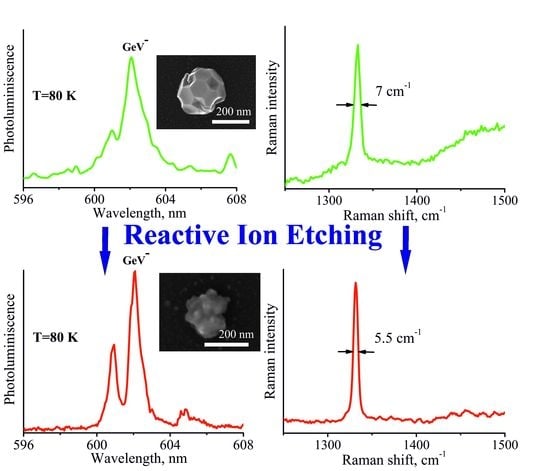Effect of Reactive Ion Etching on the Luminescence of GeV Color Centers in CVD Diamond Nanocrystals
Abstract
:1. Introduction
2. Materials and Methods
2.1. The Fabrication of Nanodiamonds
2.2. Microscopy Spectroscopy, Photoluminescence and Raman Spectroscopy
3. Results
4. Discussion
5. Conclusions
Author Contributions
Funding
Data Availability Statement
Conflicts of Interest
References
- Bradac, C.; Gao, W.; Forneris, J.; Trusheim, M.E.; Aharonovich, I. Quantum Nanophotonics with Group IV Defects in Diamond. Nat. Commun. 2019, 10, 5625. [Google Scholar] [CrossRef]
- Smith, J.M.; Meynell, S.A.; Jayich, A.C.B.; Meijer, J. Colour Centre Generation in Diamond for Quantum Technologies. Nanophotonics 2019, 8, 1889–1906. [Google Scholar] [CrossRef]
- Schröder, T.; Mouradian, S.L.; Zheng, J.; Trusheim, M.E.; Walsh, M.; Chen, E.H.; Li, L.; Bayn, I.; Englund, D. Quantum Nanophotonics in Diamond. JOSA B 2016, 33, B65–B83. [Google Scholar] [CrossRef]
- Shenderova, O.A.; Shames, A.I.; Nunn, N.A.; Torelli, M.D.; Vlasov, I.; Zaitsev, A. Synthesis, Properties, and Applications of Fluorescent Diamond Particles. J. Vac. Sci. Technol. B Nanotechnol. Microelectron. Mater. Process. Meas. Phenom. 2019, 37, 030802. [Google Scholar] [CrossRef] [Green Version]
- Pezzagna, S.; Meijer, J. Quantum Computer Based on Color Centers in Diamond. Appl. Phys. Rev. 2021, 8, 011308. [Google Scholar] [CrossRef]
- Alkahtani, M.H.; Alghannam, F.; Jiang, L.; Almethen, A.; Rampersaud, A.A.; Brick, R.; Gomes, C.L.; Scully, M.O.; Hemmer, P.R. Fluorescent Nanodiamonds: Past, Present, and Future. Nanophotonics 2018, 7, 1423–1453. [Google Scholar] [CrossRef]
- Ekimov, E.A.; Kondrin, M.V. Vacancy–Impurity Centers in Diamond: Prospects for Synthesis and Applications. Phys. Usp. 2017, 60, 539. [Google Scholar] [CrossRef]
- Chen, D.; Zheludev, N.; Gao, W. Building Blocks for Quantum Network Based on Group-IV Split-Vacancy Centers in Diamond. Adv. Quantum Technol. 2020, 3, 1900069. [Google Scholar] [CrossRef]
- Blakley, S.; Liu, X.; Fedotov, I.; Cojocaru, I.; Vincent, C.; Alkahtani, M.; Becker, J.; Kieschnick, M.; Lühman, T.; Meijer, J.; et al. Fiber-Optic Quantum Thermometry with Germanium-Vacancy Centers in Diamond. ACS Photonics 2019, 6, 1690–1693. [Google Scholar] [CrossRef]
- Trycz, A.; Regan, B.; Kianinia, M.; Bray, K.; Toth, M.; Aharonovich, I. Bottom up Engineering of Single Crystal Diamond Membranes with Germanium Vacancy Color Centers. Opt. Mater. Express 2019, 9, 4708–4715. [Google Scholar] [CrossRef]
- Palyanov, Y.N.; Kupriyanov, I.N.; Borzdov, Y.M.; Surovtsev, N.V. Germanium: A New Catalyst for Diamond Synthesis and a New Optically Active Impurity in Diamond. Sci. Rep. 2015, 5, 14789. [Google Scholar] [CrossRef] [Green Version]
- Boldyrev, K.; Mavrin, B.; Sherin, P.S.; Popova, M. Bright Luminescence of Diamonds with Ge-V Centers. J. Lumin. 2018, 193, 119–124. [Google Scholar] [CrossRef]
- Fan, J.-W.; Cojocaru, I.; Becker, J.; Fedotov, I.V.; Alkahtani, M.H.A.; Alajlan, A.; Blakley, S.; Rezaee, M.; Lyamkina, A.; Palyanov, Y.N.; et al. Germanium-Vacancy Color Center in Diamond as a Temperature Sensor. ACS Photonics 2018, 5, 765–770. [Google Scholar] [CrossRef] [Green Version]
- Sipahigil, A.; Jahnke, K.D.; Rogers, L.J.; Teraji, T.; Isoya, J.; Zibrov, A.S.; Jelezko, F.; Lukin, M.D. Indistinguishable Photons from Separated Silicon-Vacancy Centers in Diamond. Phys. Rev. Lett. 2014, 113, 113602. [Google Scholar] [CrossRef] [Green Version]
- Siampour, H.; Wang, O.; Zenin, V.A.; Boroviks, S.; Siyushev, P.; Yang, Y.; Davydov, V.A.; Kulikova, L.F.; Agafonov, V.N.; Kubanek, A.; et al. Ultrabright Single-Photon Emission from Germanium-Vacancy Zero-Phonon Lines: Deterministic Emitter-Waveguide Interfacing at Plasmonic Hot Spots. Nanophotonics 2020, 9, 953–962. [Google Scholar] [CrossRef] [Green Version]
- Rogers, L.J.; Wang, O.; Liu, Y.; Antoniuk, L.; Osterkamp, C.; Davydov, V.A.; Agafonov, V.N.; Filipovski, A.B.; Jelezko, F.; Kubanek, A. Single Si-V− Centers in Low-Strain Nanodiamonds with Bulklike Spectral Properties and Nanomanipulation Capabilities. Phys. Rev. Appl. 2019, 11, 024073. [Google Scholar] [CrossRef] [Green Version]
- Kumar, S.; Wu, C.; Komisar, D.; Kan, Y.; Kulikova, L.F.; Davydov, V.A.; Agafonov, V.N.; Bozhevolnyi, S.I. Fluorescence Enhancement of a Single Germanium Vacancy Center in a Nanodiamond by a Plasmonic Bragg Cavity. J. Chem. Phys. 2021, 154, 044303. [Google Scholar] [CrossRef] [PubMed]
- Maity, S.; Shao, L.; Sohn, Y.-I.; Meesala, S.; Machielse, B.; Bielejec, E.; Markham, M.; Lončar, M. Spectral Alignment of Single-Photon Emitters in Diamond Using Strain Gradient. Phys. Rev. Appl. 2018, 10, 024050. [Google Scholar] [CrossRef] [Green Version]
- Arend, C.; Appel, P.; Becker, J.N.; Schmidt, M.; Fischer, M.; Gsell, S.; Schreck, M.; Becher, C.; Maletinsky, P.; Neu, E. Site Selective Growth of Heteroepitaxial Diamond Nanoislands Containing Single SiV Centers. Appl. Phys. Lett. 2016, 108, 063111. [Google Scholar] [CrossRef] [Green Version]
- Lindner, S.; Bommer, A.; Muzha, A.; Krueger, A.; Gines, L.; Mandal, S.; Williams, O.; Londero, E.; Gali, A.; Becher, C. Strongly Inhomogeneous Distribution of Spectral Properties of Silicon-Vacancy Color Centers in Nanodiamonds. New J. Phys. 2018, 20, 115002. [Google Scholar] [CrossRef]
- Prawer, S.; Nemanich, R.J. Raman Spectroscopy of Diamond and Doped Diamond. Philos. Trans. R. Soc. A 2004, 362, 2537–2565. [Google Scholar] [CrossRef]
- Jahnke, K.D.; Sipahigil, A.; Binder, J.M.; Doherty, M.W.; Metsch, M.; Rogers, L.J.; Manson, N.B.; Lukin, M.D.; Jelezko, F. Electron–Phonon Processes of the Silicon-Vacancy Centre in Diamond. New J. Phys. 2015, 17, 043011. [Google Scholar] [CrossRef] [Green Version]
- Grudinkin, S.; Feoktistov, N.; Bogdanov, K.; Baranov, A.; Golubev, V. Photoluminescence of Germanium-Vacancy Color Centers in Diamond Particles Obtained by Chemical Vapor Deposition. Phys. Solid State 2020, 62, 919–925. [Google Scholar] [CrossRef]
- Feoktistov, N.; Sakharov, V.; Serenkov, I.; Tolmachev, V.; Korkin, I.; Aleksenskii, A.; Vul, A.Y.; Golubev, V. Aerosol Deposition of Detonation Nanodiamonds Used as Nucleation Centers for the Growth of Nanocrystalline Diamond Films and Isolated Particles. Tech. Phys. 2011, 56, 718–724. [Google Scholar] [CrossRef]
- Manson, N.; Harrison, J. Photo-Ionization of the Nitrogen-Vacancy Center in Diamond. Diam. Relat. Mater. 2005, 14, 1705–1710. [Google Scholar] [CrossRef]
- Dong, B.; Shi, C.; Xu, Z.; Wang, K.; Luo, H.; Sun, F.; Wang, P.; Wu, E.; Zhang, K.; Liu, J.; et al. Temperature Dependence of Optical Centers in Ib Diamond Characterized by Photoluminescence Spectra. Diam. Relat. Mater. 2021, 116, 108389. [Google Scholar] [CrossRef]
- Neu, E.; Guldner, F.; Arend, C.; Liang, Y.; Ghodbane, S.; Sternschulte, H.; Steinmüller-Nethl, D.; Krueger, A.; Becher, C. Low Temperature Investigations and Surface Treatments of Colloidal Narrowband Fluorescent Nanodiamonds. J. Appl. Phys. 2013, 113, 203507. [Google Scholar] [CrossRef] [Green Version]
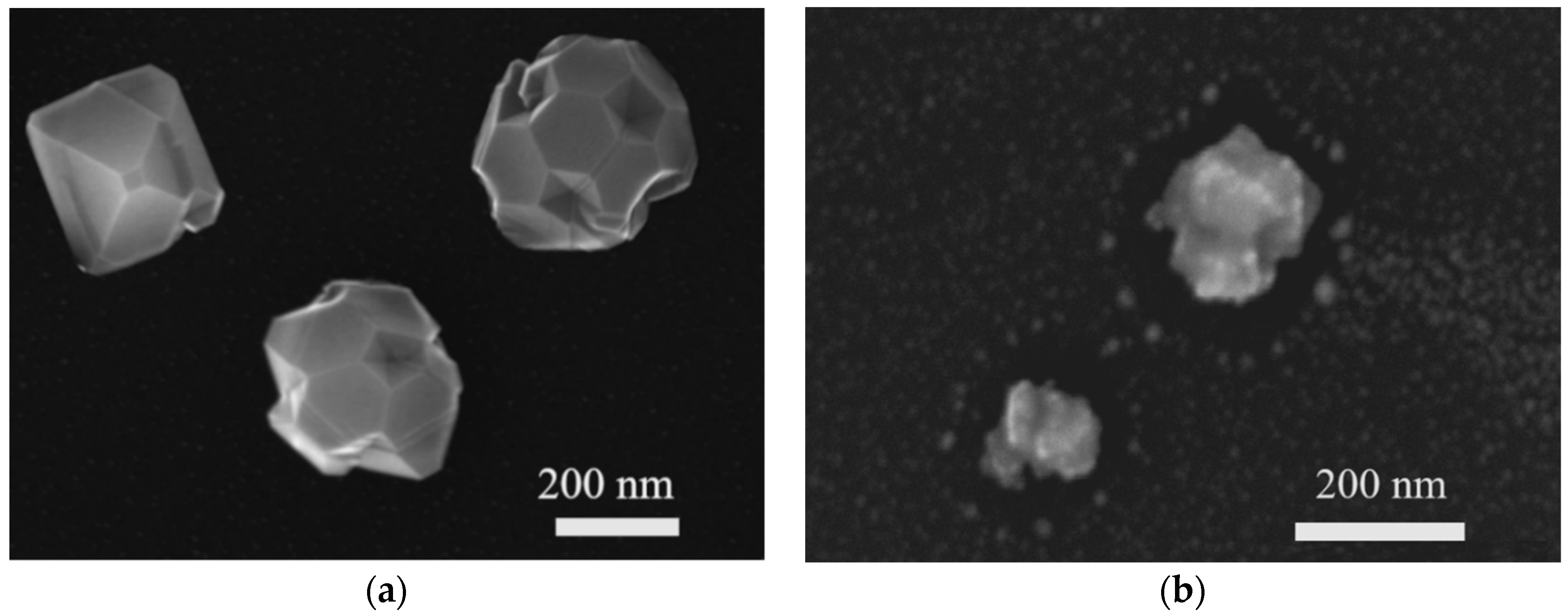
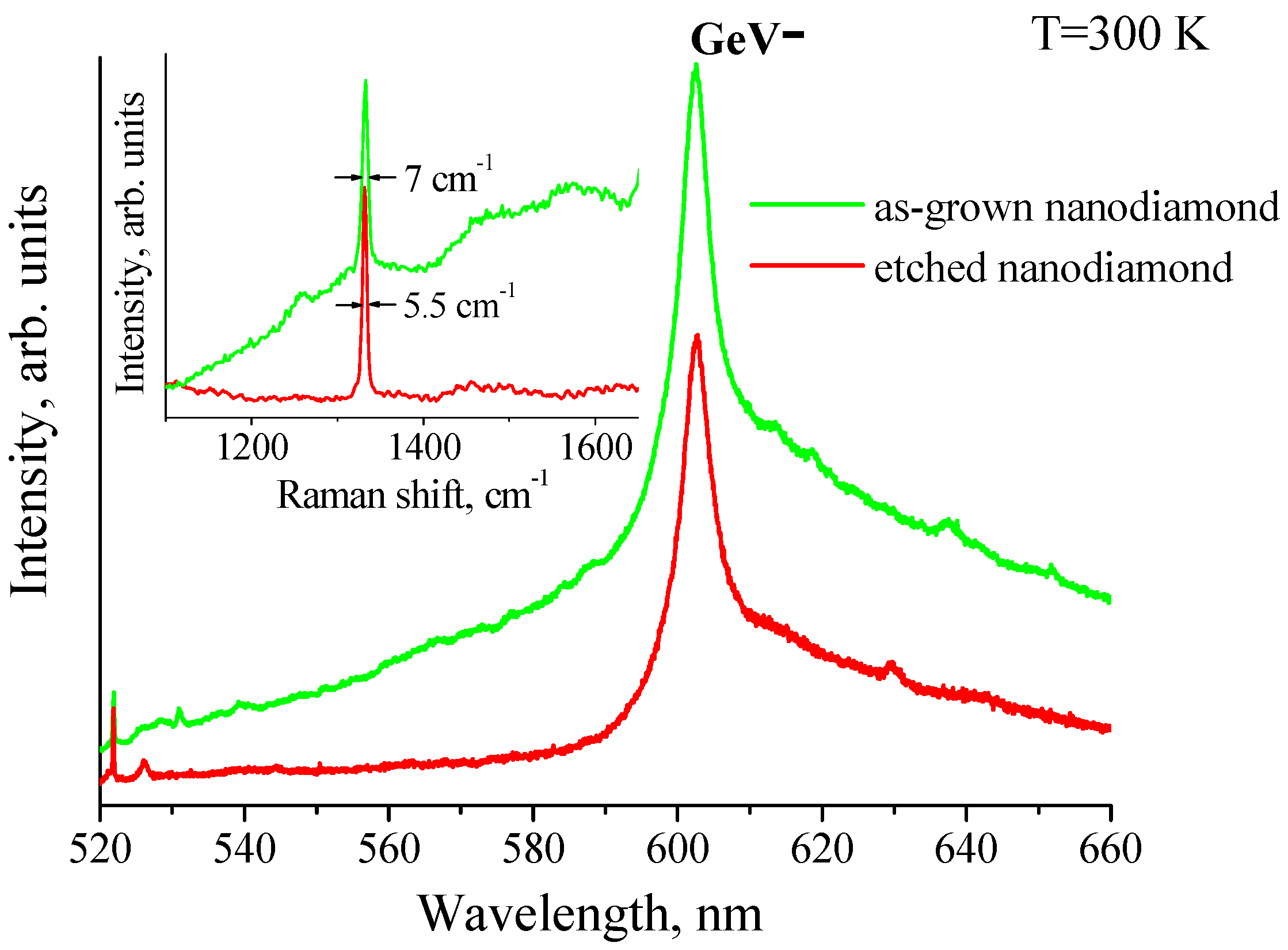
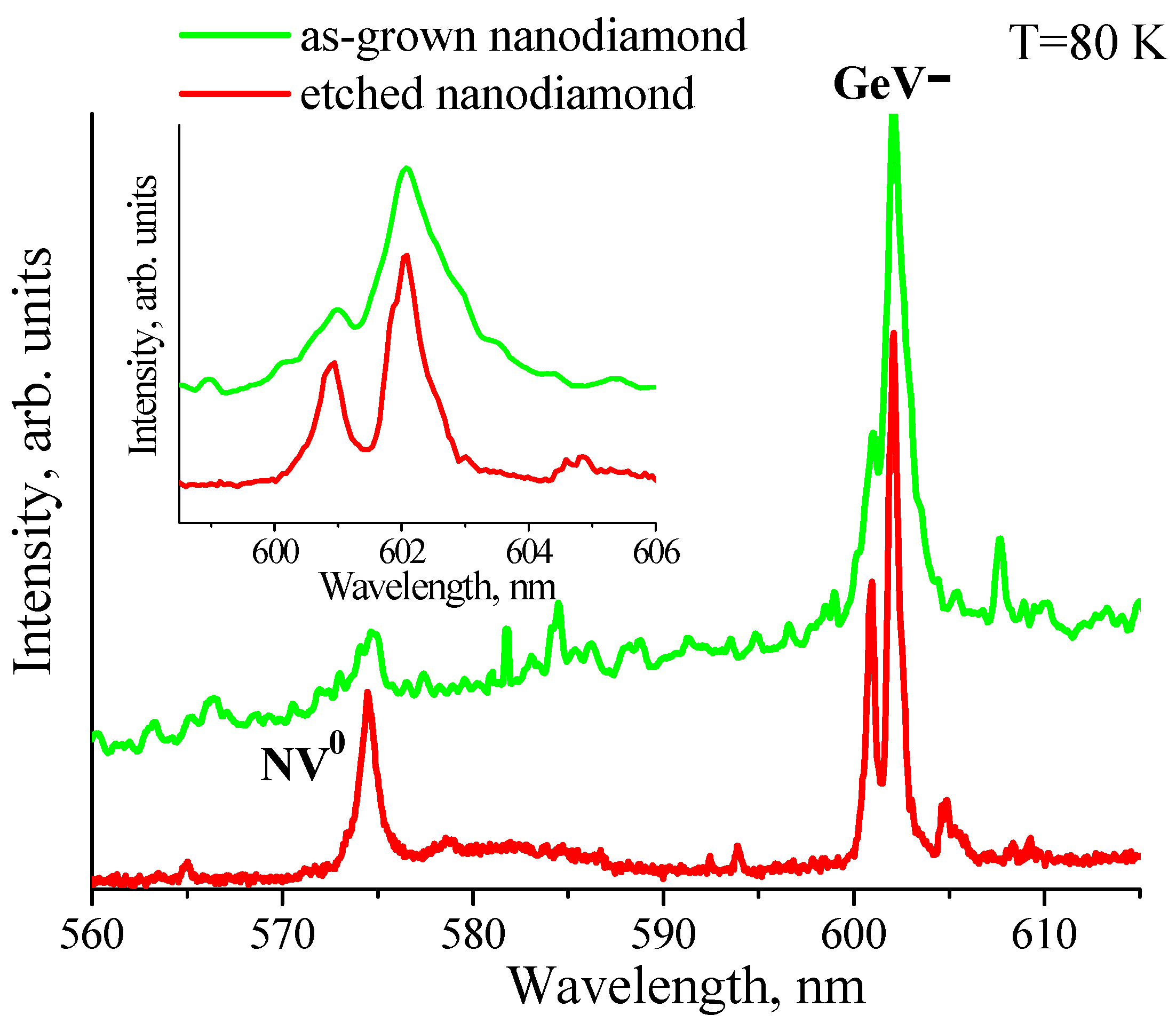
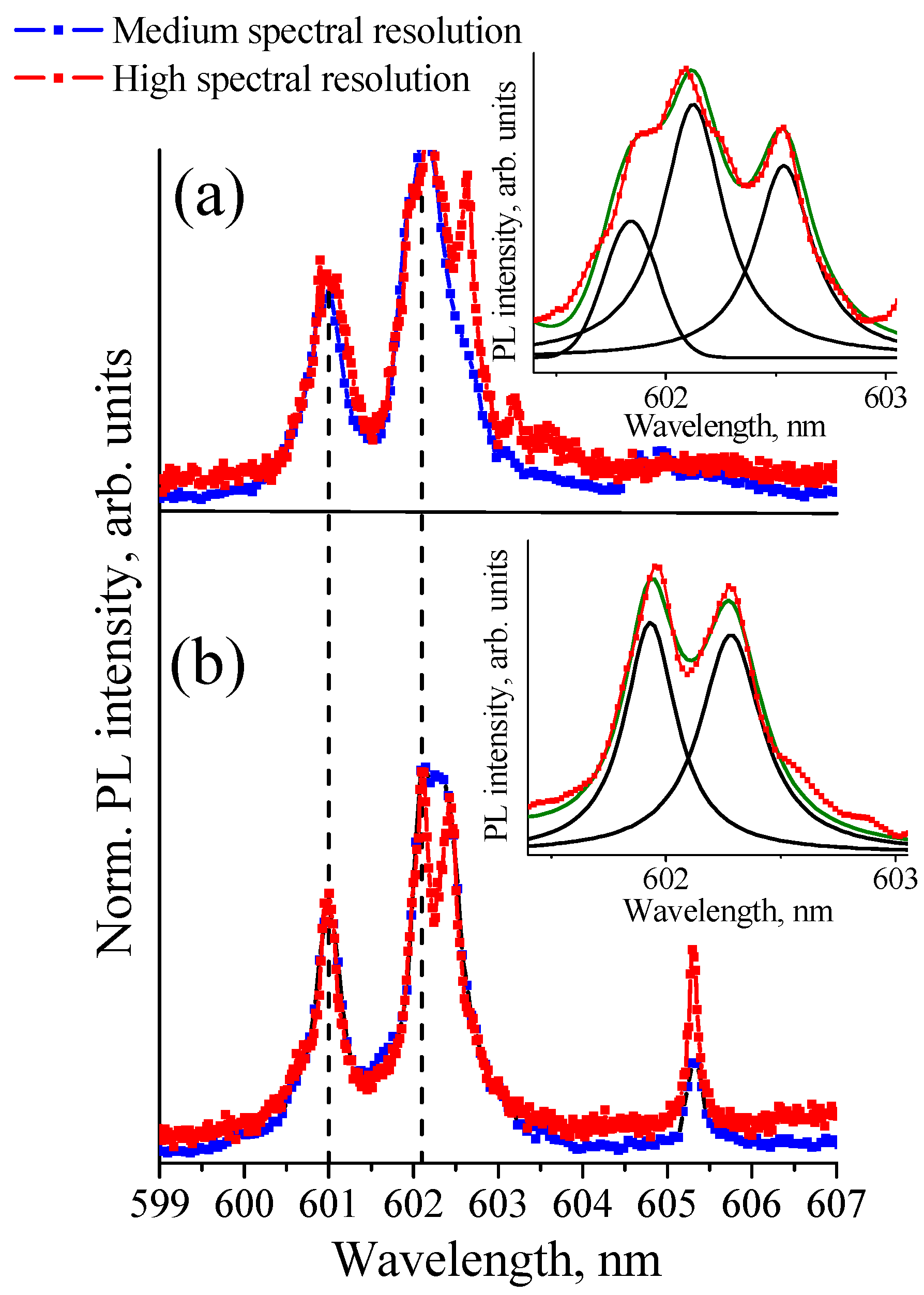
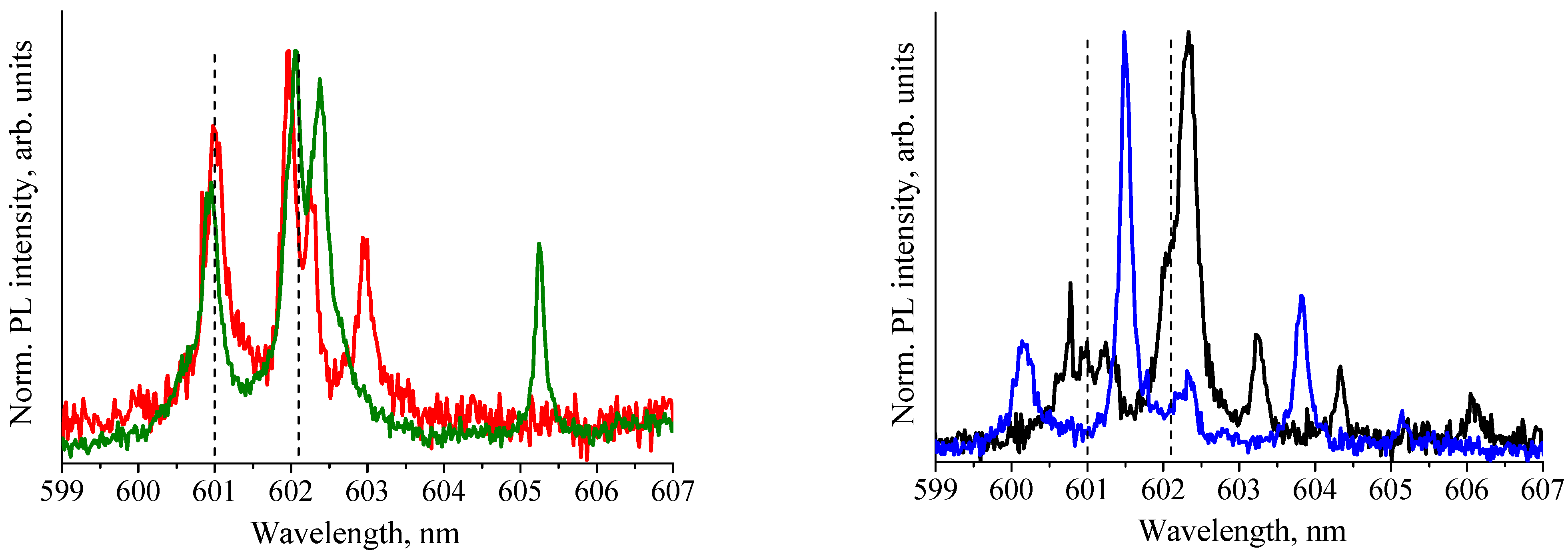
Publisher’s Note: MDPI stays neutral with regard to jurisdictional claims in published maps and institutional affiliations. |
© 2021 by the authors. Licensee MDPI, Basel, Switzerland. This article is an open access article distributed under the terms and conditions of the Creative Commons Attribution (CC BY) license (https://creativecommons.org/licenses/by/4.0/).
Share and Cite
Grudinkin, S.A.; Feoktistov, N.A.; Bogdanov, K.V.; Baranov, M.A.; Golubev, V.G.; Baranov, A.V. Effect of Reactive Ion Etching on the Luminescence of GeV Color Centers in CVD Diamond Nanocrystals. Nanomaterials 2021, 11, 2814. https://doi.org/10.3390/nano11112814
Grudinkin SA, Feoktistov NA, Bogdanov KV, Baranov MA, Golubev VG, Baranov AV. Effect of Reactive Ion Etching on the Luminescence of GeV Color Centers in CVD Diamond Nanocrystals. Nanomaterials. 2021; 11(11):2814. https://doi.org/10.3390/nano11112814
Chicago/Turabian StyleGrudinkin, Sergey A., Nikolay A. Feoktistov, Kirill V. Bogdanov, Mikhail A. Baranov, Valery G. Golubev, and Alexander V. Baranov. 2021. "Effect of Reactive Ion Etching on the Luminescence of GeV Color Centers in CVD Diamond Nanocrystals" Nanomaterials 11, no. 11: 2814. https://doi.org/10.3390/nano11112814
APA StyleGrudinkin, S. A., Feoktistov, N. A., Bogdanov, K. V., Baranov, M. A., Golubev, V. G., & Baranov, A. V. (2021). Effect of Reactive Ion Etching on the Luminescence of GeV Color Centers in CVD Diamond Nanocrystals. Nanomaterials, 11(11), 2814. https://doi.org/10.3390/nano11112814






